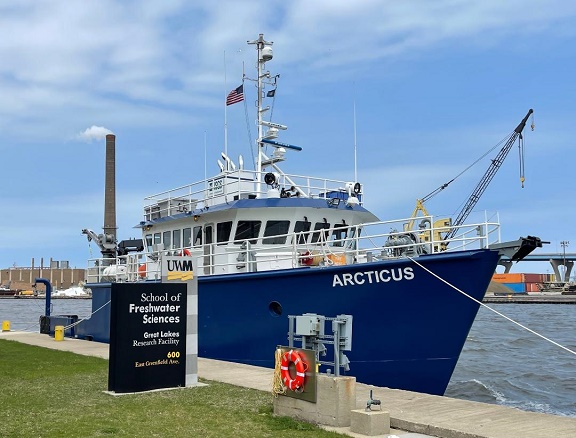
The ARCTICUS’ Galley Is Home to the Only Arctic Grayling on the Great Lakes
By James Heinz
This is the story of a research vessel, named for a Great Lakes fish that no longer inhabits the Great Lakes basin, which does fishery research for an organization that studies rocks, and all of this because of the spotted owl.
As you may have guessed, something this complicated must be part of the federal government. And it is.
It all started in 1993. At that time the U.S. Fish and Wildlife Service (FWS) had two roles: research and resource management. A FWS study of the endangered spotted owl produced controversial results.
Then Secretary of the Interior Bruce Babbitt felt that research should be made an independent function not affected by politics. He decided to remove the research function from FWS and transfer it to something he created called the National Biological Survey. Congressional opposition led Babbitt to transfer the former FWS research function from the NBS to the U.S. Geological Survey, an agency with absolutely no experience in conducting research on fish and wildlife populations. It remains there today.
Such are the ways of government service.
And in 2014 the research vessel ARCTICUS was launched at Burger Boat Company in Manitowoc, Wisconsin, to continue research into the fish populations of Lakes Huron and Michigan. I had seen the ARCTICUS docked at the Great Lakes Water Institute on East Greenfield Avenue in Milwaukee, Wisconsin on several occasions. On September 25, 2022, I saw her there again while attending Harborfest. The USGS gave me permission to board the vessel and interview her crew.
Her engineer, Chad “Odie” Mushlock, told me that the vessel is 77.3 feet long, 26 feet wide, displaces 148 gross tons, and draws 11 feet of water. She is made of steel, and has twin propellers driven by two Caterpillar C-12 1,000 horsepower diesel engines, each of which also drives a Caterpillar C-4 electric generators. The ship also has a bow thruster to assist her in docking. She has a total of eight berths, so with a crew of three, she can carry a maximum of five scientists.
The senior scientist on board is Chuck Madenjian, who has a PhD in zoology. Chuck explained that the purpose of the ARCTICUS is to conduct bottom trawl net studies of the bottom dwelling prey species population of the Lake Michigan and Lake Huron. The species studied are: alewives, rainbow smelt, a fish known as the bloater or chub, the round goby, and two species of sculpin: the slimy sculpin and the deepwater sculpin.
Several of these species are not native to the Great Lakes. The alewife entered the Great Lakes from the Atlantic through the Welland Canal. The rainbow smelt had been planted in an inland Michigan lake by the State of Michigan, but somehow escaped into the Great Lakes. The round goby came from the Black Sea and Caspian Sea in the ballast water of Russian freighters.
The ARCTICUS is named for a once upon a time Great Lakes fish: Thymallus arcticus, or the Arctic grayling. The grayling was once common in the Great Lakes basin but Dr. Chuck explained that it required streams sheltered by the forest canopy to thrive, and deforestation and other causes made the grayling extinct in the Great Lakes by 1940. Only one Arctic grayling remains in the Great Lakes, and it is stuffed and mounted on the wall of its namesake ship’s galley.
Dr. Chuck and Odie gave me a tour of the back deck, where the bottom trawling action takes place. Wikipedia describes bottom trawling thusly: “Bottom trawling is towing the trawl along (benthic trawling) or close to (demersal trawling) the sea floor. Bottom trawling is an industrial fishing method in which a large net with heavy weights is dragged across the seafloor, scooping up everything in its path.”
The back deck contains a two ton working crane, two winches for the two trawl doors, and a double drum net winch with the trawl net wrapped around it. When deployed, the net is pyramid shaped and is 39 feet wide at the mouth or open end, tapering to a completely closed end, called the “cod end”.
The key to the operation of the trawl net are the two wooden trawl doors. The doors are attached to each side of the open end of the net by blue “lazy lines” and deploy in an upright position to keep the open end of the net open. Each trawl door has a metal runner on the bottom to counteract the buoyancy of the wood and to protect the door from damage as it is dragged across the bottom. The trawl doors are connected by steel cable to the two trawl winches on the upper B deck.
The mesh size of the net varies depending upon where on the net the mesh is. The mesh is larger at the opening of the net and grows smaller the further to the rear of the net the mesh is. The bottom of the net, which varies in color from gray to black, is protected from bottom damage by brown “chafing gear”.
The trawl net is dropped to the bottom and spends 10 minutes on the bottom after which it is pulled up over the stern reel onto the back deck, where the terminal end, or “cod end” of the net is undone. The fish the net has caught are put in blue boxes the same color as the ship’s hull and then taken into the wet lab just off the back deck for analysis. The catch varies and excess fish are thrown back.
The ARCTICUS is equipped to perform gill net fishing as well. A door or hatch on the starboard side of the hull can be opened to deploy and retrieve the gill net.
Each year the ARCTICUS conducts a survey of all of Lake Michigan and produces a report which is circulated to the Wisconsin, Michigan, Illinois, and Indiana Departments of Natural Resources and tribal agencies. The shortest time it took to complete the survey was 21 days but weather delays mean it usually means it takes 25-35 days. The ARCTICUS goes into port at the end of each day.
So what results have these surveys shown? Since 1973, the first year the survey was conducted, prey fish populations have declined. Populations of alewives and smelt have declined, and the chub population increased in the 1980s and then declined.
You might think that the decline of these species is a bad thing. And you would be wrong.
Dr. Chuck explained that by 1960 there were no predators in Lake Michigan because the primary predatory fish, the native lake trout, had become extinct. This resulted in a boom in the population of the fish that the ARCTICUS studies. In particular, the alewife population increased so rapidly that huge mounds of dead alewives clogged water intakes and piled up on beaches. The stench of alewives rotting in the summer sun was so bad that most office workers in downtown Milwaukee were sent home, and bulldozers dug mass alewife graves on the county beaches and buried mounds of them.
In 1966 the Coho salmon, which can live in either fresh or salt water, was introduced into the Great Lakes, and was followed in 1967 by the Chinook salmon. These two species, which pretty much just swim and eat alewives, along with the species of trout stocked in the lake have kept the prey species population in check. Salmon are mid water feeders and do not come to the bottom where the trawl could catch them. Salmon and trout populations are estimated by gill net surveys, surveys of angler catches, and computer population models.
Dr. Chuck and USGS Biologist Patty Dieter do not regularly check the captured fish to see what they are eating, but they do check the alewives and chubs for age. They said that an alewife “would be lucky” to make it to five years of age but a chub has a life expectancy of ten to twenty years. Age is determined by examining the fish otoliths, or ear bones. The ear bones show age in exactly the same way as tree rings show the age of a tree.
ARCTICUS Captain Shawn Parsons told me some more details about how the surveys are conducted. This year the trawling season is scheduled to go from April 18 to November 4. The ARCTICUS can cruise at 10 knots, but for trawling she moves at 2.1 to 2.6 miles per hour. Trawling cannot be conducted in waves of five feet or more since it would be too dangerous. Waves of over six feet out in Lake Michigan had kept the ARCTICUS in port tied to the dock at Great Lakes Water Institute for several days, giving me a chance to do this story.
The net is made of nylon dipped into a latex based net coating. When trawling, Shawn steers the boat and Odie and mate Dylan Stewart operate the back deck machinery. Dylan told me that he is in charge of the putting in and taking out of the nets, and alternates steering the ship with Captain Shawn.
ARCTICUS steers a criss cross grid across Lake Michigan. It goes like this: Manistique to Charlevoix to Frankfort to Ludington to Saugatuck to Waukegan to Milwaukee to Port Washington. The net is deployed in water from 18 meters to 128 meters in 9 meter increments. The lake is divided into seven sectors and the trawling checks 10-11 spots within each sector.
Captain Shawn said that there was “a lot of weather this year.” After finishing in Lake Michigan, the ARCTICUS is scheduled to go into Lake Huron and trawl the American side of that lake. The captain expects even more weather in that lake at that time of year. The ARCTICUS conducts several surveys each year and conducts acoustic surveys and other research in between. In the winter the ship is home ported at a USGS facility in Cheboygan, Michigan, with other USGS vessels and where maintenance is done.
Dr. Chuck explained that the ultimate goals of this research are to: (1) track the status of prey fish populations in the lake, and (2) restore a self-sustaining population of native lake trout to the lake. Lake trout restoration has been achieved in Lake Superior but not in the other lakes. The salmon population is reproducing but ultimately the scientists would want the lakes native predator to return and restore as much of the natural balance as possible.
____________________________________
James Heinz is the Wisconsin Marine Historical Society’s acquisitions director. He became interested in maritime history as a kid watching Jacques Cousteau’s adventures on TV. He was a Great Lakes wreck diver until three episodes of the bends forced him to retire from diving. He was a University of Wisconsin – Milwaukee police officer for thirty years. He regularly flies either a Cessna 152 or 172.
Photo at the top of page: ARCTICUS docked in Milwaukee, September 2022. Photo Credit: James Heinz
Other Photos:
Engine Room of the ARCTICUS – diesel engine in foreground, generator in background. September 2022. Photo Credit: James Heinz
The only Arctic Grayling on the Great Lakes located in the Galley of the ARCTICUS. September 2022. Photo Credit: James Heinz
Trawling drawing from Wikipedia
Stern of the ARCTICUS, Milwaukee, September 2022. Photo Credit: James Heinz
Port side Trawl Door of the ARCTICUS. September 2022. Photo Credit: James Heinz
Close up of the ARCTICUS’ net showing different sizes of the mesh. September 2022. Photo Credit: James Heinz
Nets on the ARCTICUS. September 2022. Photo Credit: James Heinz
Bridge of the ARCTICUS. September 2022. Photo Credit: James Heinz
